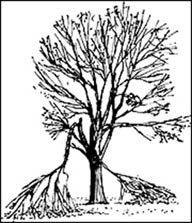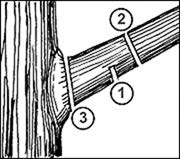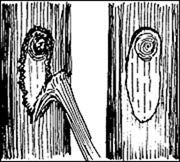AgEBB-MU CAFNR Extension
Green Horizons
Volume 23, Number 1
Winter 2019
Agroforestry
First Aid for Storm Damaged Trees: A Sequel
By Hank Stelzer| MU Extension, School of Natural Resources
Back in 2004 after the devastating Southwest Missouri ice storm, I wrote an article on first-aid for storm damaged trees. Given the recent snowstorm, I thought a reminder might be in order. The accumulation of heavy, wet snow left Missourians with leaning trees, broken limbs, split trunks, and even some uprooted trees. Unlike typical ice storm damage, eastern red cedar and other evergreens with dense foliage were severely damaged by the weight of the snow. Bradford pear, eastern cottonwood, river birch, Siberian elm, and silver maple trees were also injured. Trees with coarse branching patterns generally experienced little injury, including Ohio buckeye, hickories, black walnut, bur oak, catalpa, ginkgo, horsechestnut, and Kentucky coffeetree. In the aftermath of a severe ice, snow or wind storm, many homeowners ask a simple question about their trees: Will they survive?
Assess the Damage
Before writing off a damaged tree as a goner, ask yourself the following questions:
Other than the storm damage, is the tree basically healthy and vigorous? If the tree is basically healthy, is not creating a hazard, and did not suffer major structural damage, it will generally recover if first aid measures are applied.
Are major limbs broken? The larger a broken limb is, the harder it will be for the tree to recover from the damage. If a majority of the main branches are gone, the tree may have little chance of surviving.
Has the leader (the main upward-trending branch on most trees) been lost? In species where a leader is important to upward growth or desirable appearance, this may have to be a judgment call. The tree may live without its leader but, at best, would be a stunted or deformed version of the original.
Is at least 50 percent of the tree's crown (branches) still intact? This is a good rule of thumb on tree survivability. A tree with less than half of its branches remaining may not be able to produce enough foliage to nourish the tree through the coming growing season.
How big are the wounds where branches have been broken or bark has been damaged? The larger the wound is in relation to the size of the limb, the less likely it is to heal, leaving the tree vulnerable to disease and pests. A 2- to 3- inch wound on a 12-inch diameter limb will seal over with new bark within a couple of years.
Are there remaining branches that can form a new branch structure? The remaining limbs will grow more vigorously as the tree tries to replace its missing foliage. Check if branches are in place that can eventually fill out the tree's appearance.
Is the tree of a desirable species for its location? The best decision may be to remove the tree if the tree is not only seriously damaged but also is in the wrong location, such as a potentially tall tree beneath a power line, or is an undesirable species for the property.
Make a Decision
The questions listed above will help you make informed decisions about your trees. In general, the decision about a particular tree will fall into one of three categories.
 |
|
Keep it. If damage is relatively slight, prune the broken branches, repair torn bark or rough edges around wounds, and let the tree begin the process of wound repair. A mature shade tree can usually survive the loss of one major limb. The broken branch should be pruned back to the trunk. In the following months, large wounds should be monitored closely for signs of decay. Young trees can sustain quite a bit of damage and still recover quickly. If the leader is intact and the structure for future branching remains, remove the broken branches and let the tree close over the wounds and recover itself.
 |
|
Wait and see. Resist the temptation to simply cut down the tree and be done with it. Wait a while and think it over. Remember, time is on your side. Carefully prune broken branches. Then, give the tree some time to recover. You can make a final decision later.
Also resist the temptation to prune too heavily. The tree will need all the foliage it can produce to survive the next growing season. Remove only the damaged limbs, then wait andsee how the tree does. For large trees, a professional arborist should be brought in to assess damage on a borderline situation and to safely accomplish needed pruning and branch removal.
 |
|
Replace it. Some trees simply can't be saved or are not worth saving. If the tree has already been weakened by disease, the trunk is split, or more than 50 percent of the crown is gone, the tree has lost its survival edge. A rotten inner core in the trunk or structural weakness in branching patterns can cause a split trunk - the tree equivalent of a heart attack. The wounds are too large to ever mend, and the tree has lost its sap lifeline between roots and leaves. This tree is all but dead.
Basic tree first aid you can provide
Resist the urge to over-prune. Don't worry if the tree's appearance isn't perfect. With branches gone, trees may look unbalanced or naked. You'll be surprised at how fast they will heal, grow new foliage and return to their natural beauty.
 |
|
Remove any broken branches still attached to the tree. Removing the jagged remains of smaller broken limbs is a common repair property owners can make after a storm. Done properly (see photo, right), it will minimize the risk of decay agents entering the wound. Prune smaller branches at the point where they join larger ones. Cut large broken branches back to the trunk or a main limb. As you prune, make clean cuts in the sequence shown in figure to the left to help the tree to recover faster.
 |
|
Repair torn bark. To improve the tree's appearance and eliminate hiding places for insects, carefully use a sharp chisel or knife to smooth the ragged edges of wounds where bark has been torn away. Try not to expose any more of the cambium (greenish inner bark) than necessary because these fragile layers contain the tree's food and water lifelines between roots and leaves.
Don't top your trees! Untrained individuals may urge you to cut back all of the tree's branches in the mistaken belief that reducing the length of branches will help avoid breakage in future storms. Although storm damage may not allow for ideal pruning cuts, professional arborists say that "topping" - cutting main branches back to stubs - is one of the worst things you can do to a tree. Stubs tend to grow back many weakly attached branches that are even more likely to break when a storm strikes.
 |
|
Also, the tree will need all its resources to recover from the stress of storm damage. Topping the tree would reduce the amount of foliage, on which the tree depends for the food and nourishment needed for regrowth. A topped tree that has already sustained major storm damage is more likely to die than repair itself. At best, its recovery will be retarded, and it will almost never regain its original shape or beauty.
